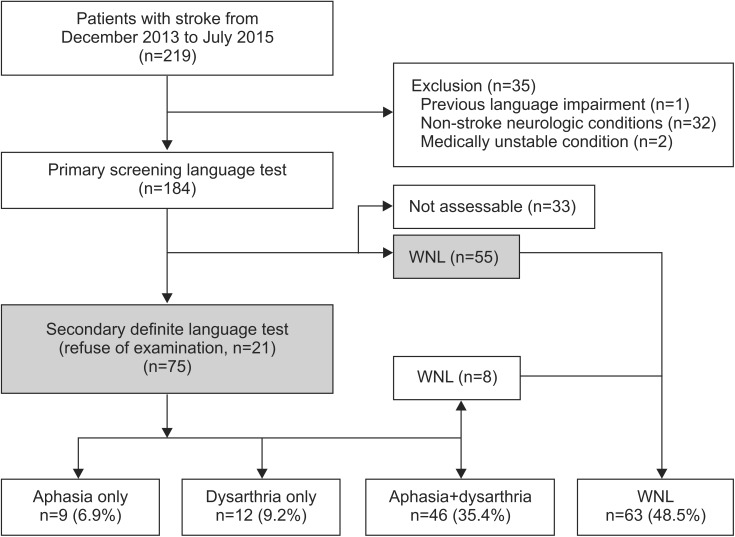Ann Rehabil Med.
2016 Dec;40(6):1010-1017. 10.5535/arm.2016.40.6.1010.
Impact of Co-occurring Dysarthria and Aphasia on Functional Recovery in Post-stroke Patients
- Affiliations
-
- 1Department of Rehabilitation Medicine, Kangwon Regional Cardiocerebrovascular Center, Kangwon National University Hospital, Chuncheon, Korea. stewardofgod@gmail.com
- 2Department of Rehabilitation Medicine, Kangwon National University School of Medicine, Chuncheon, Korea.
- KMID: 2371332
- DOI: http://doi.org/10.5535/arm.2016.40.6.1010
Abstract
OBJECTIVE
To elucidate the impact of co-occurring dysarthria and aphasia on functional recovery in post-stroke patients.
METHODS
The medical records, including results of primary screening tests and secondary definite examinations for language problems, of 130 patients admitted to our institute's Department of Rehabilitation Medicine were retrospectively reviewed. Functional outcomes were assessed longitudinally using the Functional Ambulation Category (FAC), Mini-Mental State Examination-Korean version (MMSE-K), European Quality of Life-5 Dimensions 3-Level version (EQ-5D-3L), the Korean version of the Modified Barthel index (K-MBI), and Motricity Index (MI) of the hemiplegic side.
RESULTS
Patients were classified into four groups regarding language function: aphasia only (group A, n=9), dysarthria only (group D, n=12), aphasia and dysarthria (group AD, n=46), and none (group N, n=55). The initial functional outcome scores in the group AD were significantly poor compared to those of the groups N and A. Within groups, there were significant improvements in all outcome measurements in the groups AD and N. A between-group analysis revealed significant improvements in K-MBI for the group AD after adjusting for the initial severity and patient's age compared to other groups.
CONCLUSION
Post-stroke patients suffering from aphasia with dysarthria showed significantly lower initial functional level and relatively wide range of recovery potential in activities of daily living compared to patients without language problems.
Keyword
MeSH Terms
Figure
Reference
-
1. Wade DT, Hewer RL, David RM, Enderby PM. Aphasia after stroke: natural history and associated deficits. J Neurol Neurosurg Psychiatry. 1986; 49:11–16. PMID: 2420939.
Article2. Simm WA, Roberts PE, Joyce MJ. Dysarthric speech measures for use in evidence-based speech therapy. In : Clarkson J, Langdon P, Robinson P, editors. Designing accessible technology. London: Springer;2006. p. 155–164.3. Davidson B, Howe T, Worrall L, Hickson L, Togher L. Social participation for older people with aphasia: the impact of communication disability on friendships. Top Stroke Rehabil. 2008; 15:325–340. PMID: 18782736.
Article4. Bakas T, Kroenke K, Plue LD, Perkins SM, Williams LS. Outcomes among family caregivers of aphasic versus nonaphasic stroke survivors. Rehabil Nurs. 2006; 31:33–42. PMID: 16422043.
Article5. Dickson S, Barbour RS, Brady M, Clark AM, Paton G. Patients' experiences of disruptions associated with post-stroke dysarthria. Int J Lang Commun Disord. 2008; 43:135–153. PMID: 18283594.
Article6. Trapl M, Eckhardt R, Bosak P, Brainin M. Early recognition of speech and speech-associated disorders after acute stroke. Wien Med Wochenschr. 2004; 154:571–576. PMID: 15675431.
Article7. Ali M, Lyden P, Brady M. Aphasia and dysarthria in acute stroke: recovery and functional outcome. Int J Stroke. 2015; 10:400–406.
Article8. Lee KM, Jang YH, Kim YH, Moon SK, Park JH, Park SW, et al. Reliability and validity of Korean version of National Institutes of Health Stroke Scale: multi-center study. J Korean Acad Rehabil Med. 2004; 28:422–435.9. Kim H, Na DL. Paradise Korean version of the Western Aphasia Battery (K-WAB). Seoul: Paradise Welfare Foundation, Institute for Children with Disabilities;2001.10. Shin MJ, Lee SB, Lee SY. Speech mechanism screening test (SMST). Seoul: Hakjisa;2010.11. Jung HY, Park BK, Shin HS, Kang YK, Pyun SB, Paik NJ, et al. Development of the Korean version of Modified Barthel Index (K-MBI): multi-center study for subjects with stroke. J Korean Acad Rehabil Med. 2007; 31:283–297.12. Mehrholz J, Wagner K, Rutte K, Meissner D, Pohl M. Predictive validity and responsiveness of the functional ambulation category in hemiparetic patients after stroke. Arch Phys Med Rehabil. 2007; 88:1314–1319. PMID: 17908575.
Article13. Park JH, Kwon YC. Standardization of Korean version of the Mini-Mental State Examination (MMSE-K) for use in the elderly. Part II: Diagnostic validity. J Korean Neuropsychiatr Assoc. 1989; 28:508–513.14. Shah S, Vanclay F, Cooper B. Predicting discharge status at commencement of stroke rehabilitation. Stroke. 1989; 20:766–769. PMID: 2728043.
Article15. Franchignoni FP, Tesio L, Ricupero C, Martino MT. Trunk control test as an early predictor of stroke rehabilitation outcome. Stroke. 1997; 28:1382–1385. PMID: 9227687.
Article16. Jo MW, Yun SC, Lee SI. Estimating quality weights for EQ-5D health states with the time trade-off method in South Korea. Value Health. 2008; 11:1186–1189. PMID: 18489498.
Article17. Golicki D, Niewada M, Buczek J, Karlinska A, Kobayashi A, Janssen MF, et al. Validity of EQ-5D-5L in stroke. Qual Life Res. 2015; 24:845–850. PMID: 25347978.
Article18. Dickey L, Kagan A, Lindsay MP, Fang J, Rowland A, Black S. Incidence and profile of inpatient stroke-induced aphasia in Ontario, Canada. Arch Phys Med Rehabil. 2010; 91:196–202. PMID: 20159121.
Article19. Jerome D, Dehail P, Daviet JC, Lamothe G, De Seze MP, Orgogozo JM, et al. Stroke in under-75-year-olds: expectations, concerns and needs. Ann Phys Rehabil Med. 2009; 52:525–537. PMID: 19748844.20. Akosile CO, Adegoke BO, Raji NO, Anyanwu CC, Orji GC. Gait quality and physical functioning of stroke survivors with and without aphasia. Hong Kong Physiother J. 2013; 31:25–29.
Article21. Tilling K, Sterne JA, Rudd AG, Glass TA, Wityk RJ, Wolfe CD. A new method for predicting recovery after stroke. Stroke. 2001; 32:2867–2873. PMID: 11739989.
Article
- Full Text Links
- Actions
-
Cited
- CITED
-
- Close
- Share
- Similar articles
-
- Post-stroke Aphasia as a Prognostic Factor for Cognitive and Functional Changes in Patients With Stroke: Ischemic Versus Hemorrhagic
- Characteristics of Cognitive Impairment in Patients With Post-stroke Aphasia
- Clinical and Neuropsychological Characteristics of Patients with Stroke of the Basal Ganglia
- Brain Plasticity in Aphasia
- Subcortical Aphasia in Stroke Patients


